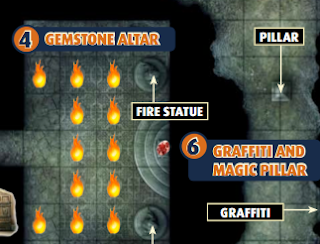I recently picked up a copy of the Pathfinder Beginner Box. I’ve been curious about this product for a while as a sort of rules-lite version of Third Edition, perhaps also playable as a complete game (a sort of E5). The very positive reviews from many parts of the OSR have also played no small part (for examples, see OD&D Discussion here, Babbling Bane here, and Tenkar here).
My exposure to Third Edition is very spotty. I missed the 3E years almost entirely. So this is also a more systematic and thorough introduction to the 3E lineage for me. In this post, I will focus on my initial impressions and on the contents of the Hero’s Handbook (the player facing part of the rules). Most of this will be from the perspective of someone who already knows how to play tabletop RPGs and just wants to use the rules, but I will also note in passing that this might be the best introductory set for a new player as well (up there with Mentzer Basic D&D and the LotFP Grindhouse Edition).
The visuals are not bad. I’m not a huge Wayne Reynolds fan, but I like the level of detail in some of his illustrations, and his work for the box cover is quite good (the two adventurers facing off against the black dragon). I’m also fond of the example fighter picture. Valeros looks like a badass, but is still grounded in reality. In terms of game aesthetics, the overall effect is reasonable. The heavily stylized “dungeon punk” look is subdued, though there is a bit of a fantasy seventeenth century vibe. There is only one silly fantasy weapon (the starknife, which is sort of like an oversized shuriken with a handle in the middle so that it can either be wielded as a melee weapon or thrown).
The graphic design is reminiscent of a video game manual, and somewhat surprisingly that is a positive thing. I remember paging through the strategy guides for early Dragon Warrior and Final Fantasy games and using them as inspiration for my tabletop games. It is that feeling that I get looking through the Beginner Box manuals.
I really like how the class descriptions and spells are presented in “level-up” blocks, but the power inflation is notable in comparison to TSR editions. Each class has a few extra goodies (like the wizard’s “arcane bond” feature which gives the character a magic item that allows casting one spell per day without preparation). Hit dice are d10 (fighter), d8 (cleric and rogue), and d6 (wizard). (People can’t seem to stop bumping the thief’s hit die up.) Full HP are granted at first level. In terms of complexity, the caster classes take up 6 pages each (this includes all spells available for the levels covered) and the fighter and rogue take up two pages each (though half the fighter class is hidden in the section on feats and half the rogue class is hidden in the section on skills). In general, this feels manageable and flexible. This level of power advancement is not a problem if you top out at 5th level.
Both of the caster classes are unfortunately a bit bland, and not in an the archetypal “imagination fuel” way. The available wizard schools are universalist, evocation, and illusion (boring) and each grant a few extra powers usable several times per day (for example, the illusionist can use a magical disguise once per day and the evocation specialist gets a free daily burning hands and some force missiles). Cleric “orisons” (that is, at-will powers), include light, read magic, and detect magic. That’s right, as long as you have a cleric, you never need to worry about light sources. Wizard cantrips (at-will powers, in Pathfinder), include detect magic, mage hand (minor telekinesis), ray of frost (1d3 damage with 30 foot range), and read magic. This is a bit more than I would like characters to begin with, but I can work with it. The augury spell (available to clerics at third level) is an abomination and should be excised.
The fighter, wizard, and rogue are all recognizable takes on the traditional classes, though the rogue is significantly more combat-focused. The cleric, however, bears less relation to the traditional mace-wielding undead-smiting holy warrior. This seems like a strange choice for an introductory set. None of the gods resonate with me; they all seem like generic invented fantasy gods.
Demihumans keep getting bigger and bigger! Dwarves are described as on average about a foot shorter than humans. So, dwarves must be around 4½ to 5½ feet tall. That is much larger than I have ever pictured dwarves in a fantasy world. And elves are described as taller than humans. There’s nothing really wrong with these changes, I just think they are odd choices for default archetypal fantasy races. These are minor aesthetic details, but still worth noting.
The overall impression I get from the Beginner Box is that the system is tractable, and this is a very good thing. It seems like it would be possible to understand relatively completely without an obscene time investment. Character generation, though still more complicated than I would like, is not too cumbersome. As Zenopus says, the Pathfinder Beginner Box really is an homage to the classic basic sets, and it includes many nods to the style of traditional D&D as well, though many of them are contained in the Game Master’s Guide and so will be covered in another post.






